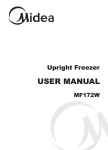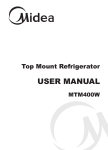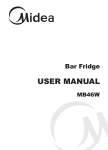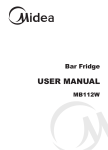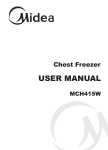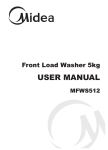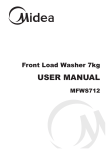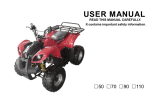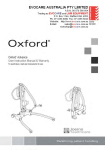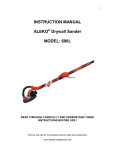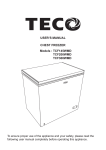Download Midea_MR237W_manual - to open Midea website.
Transcript
Single Door Refrigerator USER MANUAL MR237W CONTENTS Safety information ........................................ 2-3 Identifying parts of the refrigerator ........................................ 4 Transporting ........................................ 5 Installation ........................................ 5 Reversing the door ........................................ 6-7 Operating instructions ........................................ 8 Cleaning & Maintenance ........................................ 8-9 Energy saving tips ........................................ 10 Disconnection of the appliance ........................................ 10 Troubleshooting Guide ........................................ 11 Repairs, Service & Warranty ........................................ 12 Specifications ........................................ 13 1 SAFETY INFORMATION Congratulations on your new Midea refrigerator. This manual contains important information on the installation, use and care of your appliance. Please read this manual carefully before use. Follow instructions and keep the manual for future reference. The appliance is specifically constructed for domestic use and is therefore suitable for the refrigeration and storage of fresh food. The appliance has not been designed or manufactured for professional use. Midea declines all responsibility for damage deriving from improper use of the appliance. The refrigerator has undergone the necessary tests on the tightness of the refrigeration circuit and complies with the safety regulations. WARNING WARNING The WARNING symbol indicates information that concerns your personal safety CAUTION The CAUTION symbol indicates information on avoiding damage to the appliance CAUTION R600a WARNING LABEL R600a R600a Refrigerant Warning · This appliance contains a small quantity of flammable, non-synthetic R600a refrigerant. · Ensure that the tubing of the refrigerant circuit is not damaged during transportation and R600a installation. · Ensure careful installing, handling and disposing to avoid safety hazards. If accidental damage occurs, keep the appliance away from open fires or devices that produce sparks, unplug the appliance and call an authorised service agent. Thoroughly ventilate the room in which the appliance is situated for several minutes. · Leaking refrigerant may cause eye injuries or could ignite. · Hydrocarbon refrigerants have excellent refrigerant properties, minimal global warming potential and no ozone depletion potential. · Hydrocarbon refrigerants cannot be ‘retrofitted’ to an appliance that has not been designed and approved to use that type of refrigerant. · The room for installing the appliance must be at least 1m3 per 8g of refrigerant. The amount of refrigerant in the appliance can be found on the rating plate attached to the appliance. 2 SAFETY INFORMATION Safety Precautions - The refrigerator is designed to operate on a single phase power supply within a voltage range of 220-240V/50Hz. - Do not allow any sharp objects to come in contact with the refrigerant system to avoid damage to the refrigerant circuit. - This product is for indoor use only. - Do not place electrical items or cooking equipment nearby. Keep away from substances which could cause ignition and ensure good ventilation is always available. - Do not use electrical appliances inside the food storage compartments of the appliance unless they are the type recommended by the manufacturer. - Do not place objects on top of the appliance which are magnetic, heavy or filled with water. - If the supply cord is damaged, it must be replaced by authorised Midea service personal, service agent or similarly qualified persons in order to avoid a hazard. - Do not store flammable, explosive, volatile and highly corrosive materials in the refrigerator. Containers with flammable gases or liquids can leak at low temperature. There is a risk of explosion or fire. - Do not splash water on the appliance. It may cause malfunction or electric shock. - Do not place or operate any electrical appliance in the refrigerator. - Always switch off and unplug the appliance before cleaning. - This appliance is not intended for use by persons (including children) with reduced physical, sensory or mental capabilities, or lack of experience and knowledge, unless they have been given supervision or instruction concerning use of the appliance by a person responsible for their safety. Safety of children · Young children should be supervised to ensure that they do not play with the appliance. · Packing (e.g. plastic wraps, polystyrene etc.) can be dangerous for children. There is a WARNING risk of suffocation. Keep packaging materials away from children. Information on disposal Most of the packing material used is recyclable. Please separate the plastic and cardboard and dispose through your local recycling depot or place in appropriate recycling collection bins. If disposing of this appliance, please contact your local authority for safe disposal. Incorrect disposal may cause injury to the user or flammable gases may cause environmental damage. Remove the door, cut off the main cable, break or remove spring or bolt catches to prevent children from getting trapped or harming themselves. 3 IDENTIFYING PARTS OF THE REFRIGERATOR 4 1 2 5 3 6 1 Temperature control 4 Door bin with egg bracket 2 Glass shelf 5 Bottle bin 3 Fruit & vegetable drawer 6 Adjustable foot 4 TRANSPORTING Keep the refrigerator upright and avoid squeezing or vibration during transport. Avoid a slanting angle over 45 degrees during handling. Avoid the door or top cap from being under excessive stress when moving, otherwise it may become deformed. CAUTION Do not connect your refrigerator to the power supply immediately after it is placed vertically. You should keep it standing for at least 3 hours before connection to let it settle. INSTALLATION Remove all packaging material and adhesive tape before using your new refrigerator. This includes the foam base and all adhesive tape holding the refrigerator accessories inside and outside. Clean both the inside and outside of the refrigerator with a soft cloth and lukewarm soapy water. Positioning your refrigerator Place your refrigerator in a well ventilated area away from a heat source and direct sunlight. Do not install the refrigerator in a damp or wet location as this may cause damage to the insulation and result in leakage. Condensation may also build up on the outer cabinet causing rust. Use the front two adjustable feet to level the refrigerator. Rotate the feet in a clockwise direction to raise the refrigerator and anti-clockwise to lower. Ensure the refrigerator slightly tilts backwards so that the drawer and door self-close to provide a consistent closed seal. Allow for adequate ventilation around your refrigerator There should be a clearance of at least 200mm from the top of your refrigerator, and 50mm from either the sides of the refrigerator (or) the back of the unit. If the refrigerator is to sit flush with the cabinetry, then a 50mm clearance must be available to allow the door to open freely and enable the removal of bins and shelves. The minimum clearance recommended at each side is 5mm, if this is the case the door must sit proud of the cabinetry by 50mm (not flush). A 5mm side clearance will require 50mm of airspace at the back of the unit to allow for adequate ventilation. 5 50mm Minimum recommended airspace around refrigerator 50mm 50mm 5mm 5mm DOOR 50mm REVERSING THE DOOR WARNING Please ensure the refrigerator is unplugged from the main power source and any items are removed from inside the refrigerator and door bins before reversing the door. Follow below steps to reverse the door from the supplied position. step 1 1. Remove the cover from the hinge. 2. Use a phillips head screwdriver to remove the 2 screws holding the hinge in place. Support the weight of the door while removing the hinge. hinge cover hinge screws step 4 3. Lift the door off the bottom hinge and place in a safe location to prevent damage. hinge shaft sleeve door block 4. Remove the hinge shaft sleeve and door block from the bottom and relocate it to the opposite side of the door. step 5 5. Take the hinge and undo the nut holding the hinge pin. Relocate to the opposite side and fix in place. 6 REVERSING THE DOOR 6. Carefully tilt the refrigerator back to access the bottom hinge assembly. Note: Do not tilt >45°. Using a phillips head screwdriver, remove the screws holding the hinge in place. Unscrew the adjustable foot from the opposite side. step 6 adjustable foot 7. Relocate the bottom hinge to the opposite side and secure in place using the same screws from step 6. Note: Do not tighten screws completely until after the door has been correctly placed and the seal checked. Screw the adjustable foot into the opposite side. 8. Replace the screws that previously held the hinge in place from step 1. Remove the cover from the opposite side and place over screws. 9. Remove the two screws now exposed and install the top hinge. Note: Do not tighten the hinge screws completely until the door has been aligned and seals aligned. bottom hinge assembly step 7 bottom hinge assembly adjustable foot step 8 top cover replace screws here step 9 install hinge here cover installed here 10. To reverse the door handle, remove the two screw caps from the side of the handle. Unscrew both screws and remove handle. Remove the screw caps from the opposite side of the door and replace them to this side. Screw handle onto new side and replace original screw caps on handle. 11. Place the door on the top and bottom hinges, align making sure the door gasket seals correctly. Once aligned, tighten the hinge screws. 12. Replace the hinge cover. 7 OPERATING INSTRUCTIONS Controlling the temperature The temperature of the refrigerator can be controlled manually by adjusting the temperature dial. Turning the temperature dial (page 4 item 1) to position MAX will lower the interior temperature to the coldest setting. Turning the temperature dial to position MIN will increase the interior temperature to the warmest setting. MED represents a medium temperature. The default setting is MED for normal operating conditions. CLEANING & MAINTENANCE Cleaning the appliance Before cleaning: Turn appliance off at the power point, then remove the power cord from the outlet. This will make sure there is no chance of electric shock. WARNING Interior Clean the refrigerator interior regularly. Turn power off. Wipe the interior with a soft cloth and lukewarm soapy water. Wipe away any food spills thoroughly. Dry all surfaces and removable parts. Avoid getting water on the refrigerator controls. If you have taken out any removable parts, replace them and switch on the power before re-stocking the refrigerator. Exterior Clean the refrigerator with only lukewarm soapy water and a soft cloth. Rinse with clean water and then wipe the surface with a soft clean cloth to remove any soap residue. 8 CLEANING & MAINTENANCE Door seal Take care to keep the door seal clean. Sticky food and drink can cause the seal to stick to the cabinet and tear when you open the door. Wash the seal with a mild detergent and warm water. Rinse thoroughly and dry. CAUTION Never use hot water, solvents, commercial kitchen cleaners, aerosol cleaners, metal polishers, caustic or abrasive cleaners or scourers to clean the appliance as they will damage it. Many commercially available cleaning products and detergents contain solvents that will damage your refrigerator. When cleaning, using only a soft cloth and lukewarm soapy water. Empty the drip tray Do not attempt to remove the drip tray from the rear of the refrigerator. The tray may have water in it, be careful not to spill it while removing any water from the tray. Use a sponge or towel to soak up the water from the drip tray into a bucket, and discard the water appropriately. Be careful not to bump the refrigeration tubing. This should be carried out at least once a year. Replacing the Interior light WARNING Before replacing the light: Turn appliance off at the power point, then remove the power cord from the outlet. This will make sure there is no chance of electric shock. Remove the cover and replace the light bulb with a screw type base (240V/15W) bulb. 1. Remove the cover by pulling the cover outward in the direction of the arrow. 2. Rotate the bulb in a counterclockwise direction and remove. Please check the points below after maintenance: (1) Is there any damage to the power lead? (2) Can the power plug be inserted into the power socket correctly? (3) Is the power plug and/or lead heating up? 9 ENERGY SAVING TIPS 1. Reduce opening the door frequently. This will increase the appliance efficiency and reduce power consumption. 2. To maintain good air circulation within the refrigerator cabinet, keep the shelves, fruit and vegetable drawer in the original positions as supplied. 3. There should always be some space between food items for proper air circulation. 4. Hot food should be cooled down before placing into the appliance, otherwise the interior temperature and power consumption will increase. DISCONNECTION OF THE APPLIANCE If unplugging the appliance from the power outlet, please leave at least 5 minutes before re-connection. CAUTION 1. Power failure During a power failure, do not put additional food in the appliance and reduce opening the door. If power failure is anticipated beforehand, place several ice cubes into a container and place in the top of the refrigerator. 2. Power failure during vacation Before departure of a short vacation, remove any items that could spoil if a power failure occurs, and ensure the door is closed firmly. If going on a long vacation, remove all items, clean and wipe dry the internal of the appliance, disconnect the power and leave the door open. 3. Storage of appliance If the refrigerator needs to be switched off for a long period of time (storage), remove all items, unplug the appliance from the power outlet, clean and wipe dry the interior. The door should be wedged open slightly for air circulation in order to prevent unpleasant odours. 10 TROUBLESHOOTING GUIDE If you think something may be wrong with your refrigerator, you can carry out some easy checks before calling for service. You may locate the problem and spare yourself from inconvenience, saving time and money. SYMPTOM Refrigerator is not operating SUGGESTION · Check that the power cord is plugged into the power outlet properly and that the outlet is switched “ON”. · Try running another appliance from the power outlet. If no power is coming from the outlet you may have blown a fuse or tripped a circuit of your household power supply. · Try adjusting the temperature control to a slightly “colder” position. Unusual noise · The flow of refrigerant through the pipeline coil could cause gurgling, similar to water boiling. This is the normal function of the appliance. · It is quite normal for noise to seem louder just after the refrigerator starts operating. · Other strange sounds may mean that you need to check and take action. For example, noises may mean that: - The cabinet is not level. - The floor is uneven or weak. - Bottles are badly placed and rattling. - There are vibrations from an object on top of or behind or beside the refrigerator. - The back of the refrigerator cabinet is touching the wall. Compressor seems to run more than expected · · · · Temperature in the refrigerator is too warm · Check that the appliance has enough clearance at the sides, back and top. Refer to installation instruction on page 5. · Refer to “Controlling the temperature” on page 8. · You may have kept the door open too long or too frequently. · Food containers or packaging may be holding a door open. Food is frozen inside the refrigerator compartment The door will not close · Check if the food is placed near the air outlet. Is door kept open too long or too often? Is control set too cold? Have large amounts of warm food just recently been stored? If the day is hot or the room is very warm, the refrigerator will need to run more than normal. · The refrigerator will run more than normal just after you install it or when it has been turned off for a long time. · Check whether the front of the refrigerator is tilted back slightly to allow the door to self close. · Check whether something is holding the door open. The following cases are not malfunctions: Moisture may form as condensation on the outside of the appliance during humid conditions. To remove excess moisture, wipe clean. It is normal that the sides of the appliance and the turnover beam will get warm as a result of the refrigeration system operation. The appliance operation could cause electrical interference to electrical equipment. 11 REPAIRS, SERVICE & WARRANTY It is hazardous for anyone installing, removing, altering, repairing servicing, testing or certifying the gas system of a gas device (i.e. charging, discharging or breaking into the refrigeration system that uses hydrocarbon refrigerants). Only an Authorised Service Person can carry out servicing or repairs to this appliance. If service is required If you have a problem which persists after you have made the checks listed in the Troubleshooting Guide, please contact: Midea Customer Care on 1300 132 371 Please refer to the enclosed warranty card or visit www.mideaappliances.com.au for warranty information. Ensure you have the appliance model number and proof of purchase handy before calling Midea Customer Care to enquire about a warranty claim. Complete and retain the following information for your records: Model No. Serial No. Date of purchase Retailer Please retain proof of purchase for warranty claims. 12 SPECIFICATIONS Model MR237W Climate class T Classification of installation and use Group 2 Indoor use only Rated Total Gross Volume 237L Voltage 220-240V / 50Hz Noise Level 42dB Refrigerant type R600a Ambient Operating temperature 43°C Dimensions Height 1420mm Width 550mm Depth 550mm IP rating IPX0 Net Weight 39Kg NOTE: · Product specifications are subject to change without prior notice. · This product is subject to continuous improvement, which may not be completely consistent with the manual, however the functions and operating methods will not change. 13 V 05/15
















